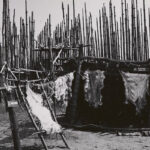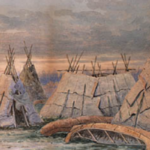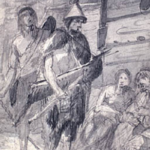The Nisga’a Nation: Pioneers of Indigenous Sovereignty
The Nisga’a Nation, whose ancestral lands lie in the Nass River Valley of northern British Columbia, have lived in this region for millennia. Known for their governance structures, rich cultural traditions, and mastery of the river’s resources, the Nisga’a have a history marked by resilience and a relentless pursuit of self-determination. The signing of the Nisga’a Final Agreement in 2000, the first modern treaty in British Columbia, stands as a testament to their perseverance and leadership in Indigenous sovereignty.
Ancient Roots: People of the Nass River Valley
The Nisga’a trace their origins to the Nass River Valley, a region they have inhabited for over 10,000 years. This lush, mountainous area, abundant with salmon and other resources, sustained a thriving society whose traditions were shaped by their environment. The Nass River, known as Lisims in Nisga’a language, was central to their way of life, serving as a source of food, transportation, and spiritual meaning.
Archaeological evidence, such as ancient fishing sites and village remains, highlights the sophistication of Nisga’a society. Their mastery of eulachon fishing, a vital resource, exemplifies their sustainable practices and cultural ingenuity. The eulachon oil trade, known as the “grease trail,” linked the Nisga’a to a vast network of coastal and interior Indigenous nations.
In The Resettlement of British Columbia, historian Cole Harris observes, “The Nass River was not just a source of subsistence for the Nisga’a; it was a cultural and economic artery that connected them to a broader world.”
Governance and Social Structures
The Nisga’a Nation was organized into four main clans—Killer Whale (G̱anada), Raven (Gisk’aast), Wolf (Laxgibuu), and Eagle (Laxsgiik)—each with distinct territories, responsibilities, and oral histories. Governance was conducted through hereditary leadership, with chiefs representing their clans in decision-making councils.
Potlatches, or feasts, were a cornerstone of Nisga’a culture, serving as venues for the distribution of wealth, the reaffirmation of social ties, and the preservation of oral histories. These ceremonies reinforced the Nisga’a’s laws and values, ensuring continuity across generations.
Marianne Ignace, in Keeping the Stories Alive, writes, “The potlatch was more than a social event for the Nisga’a; it was a legal and spiritual framework that governed their lives and sustained their identity.”
Early Trade and Interactions
The Nisga’a were integral to regional trade networks that extended across the Pacific Northwest. The Nass River was a central hub for the exchange of goods such as eulachon oil, furs, and cedar, fostering connections with neighbouring nations like the Tsimshian and Gitxsan. These relationships were not merely economic but also cultural, allowing for the exchange of ideas and alliances.
Bruce Miller, in Paths of the Coast, highlights, “The Nisga’a were at the heart of the grease trails, facilitating both trade and diplomacy in the region.”
First Contact with Europeans
European contact began in the late 18th century, with fur traders and explorers arriving in the region. Early interactions often centred around trade, as the Nisga’a provided furs and fish in exchange for European goods like metal tools, firearms, and textiles. However, these exchanges also introduced devastating diseases, including smallpox, which significantly reduced the Nisga’a population.
In Indigenous Peoples of Canada, anthropologist Bruce Trigger writes, “The arrival of Europeans brought opportunities for trade but also catastrophic epidemics that decimated Indigenous communities like the Nisga’a.”
Despite these challenges, the Nisga’a maintained their cultural practices, adapting to new circumstances while preserving their connection to the Nass River and its resources.
Colonization and Land Dispossession
The 19th century brought increased colonial encroachment on Nisga’a lands. Missionaries sought to suppress traditional practices like the potlatch, while settlers exploited the region’s resources. The imposition of Indian reserves under the Indian Act confined the Nisga’a to small portions of their ancestral territories, disrupting their traditional governance and land use.
The Nisga’a responded with resilience, becoming one of the first Indigenous nations in British Columbia to organize politically against colonial policies. In 1887, Nisga’a leaders traveled to Victoria to demand recognition of their land rights. This marked the beginning of a century-long struggle for a treaty.
The Nisga’a Treaty Movement
The Nisga’a Land Committee, formed in 1890, spearheaded efforts to reclaim their territory and assert their sovereignty. Over the decades, they brought their case to provincial and federal governments, as well as international forums. Their persistence culminated in the signing of the Nisga’a Final Agreement in 2000, after over 100 years of negotiations.
The treaty restored 2,000 square kilometers of land to the Nisga’a, provided self-governance, and granted control over resources and taxation. Historian Margaret Conrad, in A Concise History of Canada, writes, “The Nisga’a treaty was a landmark achievement, setting a precedent for Indigenous self-determination in Canada.”
Cultural Revitalization and Modern Governance
The Nisga’a Final Agreement has enabled the nation to strengthen its cultural, economic, and political foundations. The Nisga’a Lisims Government, headquartered in the village of New Aiyansh, oversees governance, education, and resource management. This self-governance model reflects the Nisga’a’s traditional systems while addressing contemporary challenges.
The Nisga’a have also prioritized cultural revitalization, including the preservation of their language, Nisga’a Sm’algyax, and the restoration of potlatch ceremonies. The Nisga’a Museum, opened in 2011, houses invaluable artifacts and serves as a cultural hub for the community.
In Keeping the Stories Alive, Marianne Ignace notes, “The Nisga’a’s commitment to preserving their language and traditions demonstrates their determination to ensure that future generations remain connected to their heritage.”
Environmental Stewardship
The Nisga’a have been leaders in environmental stewardship, managing their lands and resources in alignment with traditional knowledge. The treaty granted the Nisga’a control over forestry, fishing, and mineral rights, allowing them to balance economic development with sustainability. Projects like the Nass Wildlife Area reflect their commitment to protecting their environment for future generations.
Cole Harris, in The Resettlement of British Columbia, writes, “The Nisga’a’s approach to land management embodies a deep respect for the natural world, rooted in their cultural values.”
Conclusion: Pioneers of Sovereignty
The Nisga’a Nation’s history is one of resilience, adaptation, and leadership. From their ancient stewardship of the Nass River Valley to their groundbreaking treaty and modern governance, the Nisga’a have set a precedent for Indigenous sovereignty in Canada. Their unwavering commitment to their culture, language, and environment ensures that their legacy will endure.
As Jean Barman writes in West Beyond the West, “The Nisga’a’s journey is a testament to the strength of their identity and their determination to reclaim their place in the lands they have called home for millennia.”
References
- Barman, Jean. West Beyond the West: A History of British Columbia. University of Toronto Press, 1996.
- Carlson, Keith Thor. Living the River’s Legacy: The Fraser River and Coast Salish History. McGill-Queen’s University Press, 2011.
- Conrad, Margaret. A Concise History of Canada. Cambridge University Press, 2012.
- Fisher, Robin. Contact and Conflict: Indian-European Relations in British Columbia. UBC Press, 1997.
- Harris, Cole. The Resettlement of British Columbia: Essays on Colonialism and Geographical Change. UBC Press, 1997.
- Ignace, Marianne and Ronald E. Ignace. Keeping the Stories Alive: Language, Land, and Culture in Indigenous Communities. University of Toronto Press, 2008.
- Miller, Bruce Granville. Paths of the Coast: Trade and Diplomacy in the Coast Salish World. University of Washington Press, 2005.
- Trigger, Bruce G. Indigenous Peoples of Canada. McGill-Queen’s University Press, 1992.
- Sterritt, Neil J. Land, Rights, and Governance: The Nisga’a Experience. UBC Press, 2012.
- Nisga’a Lisims Government. Nisga’a Final Agreement: An Overview. Nisga’a Lisims Government, 2000.



